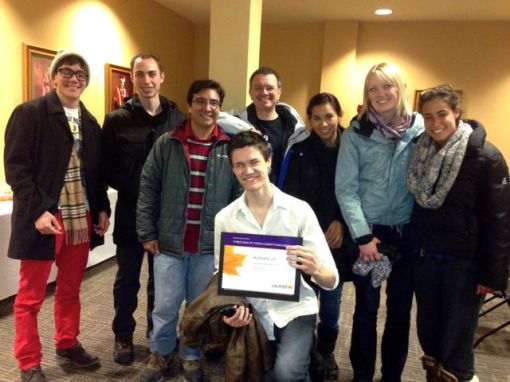Three-minute thesis 2014
Today, Scott Dobson-Mitchell was the runner up at the three-minute thesis competition (3MT) at Laurier. 
Today, Scott Dobson-Mitchell was the runner up at the three-minute thesis competition (3MT) at Laurier. 
I reacted too late. Maybe because I was at a conference.
In any event, the Nobel prizes! Take a look:
The laureates in chemistry! I used to read several articles by Martin Karplus and by Michael Levitt when I was a grad student.
Have fun!
–Gabo
Several members of The Lab of Computational conSequences went to the Canadian Society of Microbiologists conference in Ottawa last week: Lisa, Jenny, Marc, Scott, and honorary members Mike Lynch, and Laura (Lisa’s sister). All of them presented posters, Jenny gave her first talk in a scientific conference, and Mike gave a talk that I missed on exploring “the rare biosphere” (your homework to figure out what that means).
Posters were successful, Marc, who is working on the evolution of regulation of transcription by, ahem, transcription factors, had lots of visitors, the twins (Lisa and Laura) presented work on the gene cluster for cellulose biosynthesis in Bacteria, Jenny talked about 16S rRNA genes, and Scott presented a bit about phage and horizontal gene transfer.
We shall talk about these projects some time soon. We are preparing several articles and will post something about them as they are finished and submitted.
Have fun!
We have two visitors this summer to the lab of Computational conSequences:
We are talking a lot in Spanish, which is inspiring the Canadian Students in the lab to keep learning the language. Of course, we have had to explain differences between Chilean Spanish and Mexican Spanish, and it’s been fun.
We just had an Applications Note accepted in Bioinformatics. The little note presents a tool we develped to choose sets of non-redundant prokaryotic genomes (see Research-Genome Clusters too).
The tool derives from previous work where we selected sets of non-redundant prokaryotic genomes filtered at different levels of similarity for such tasks as displaying results on operon predictions, to finding the level of filtering out redundancy to maximize the number of high-quality predicted associations by phylogenetic profiles. Other groups have been using our non-redundant sets. Thus, we thought it was better to share to the wider community and we developed this tool. If you have suggestions for improvements, please let us know. We cannot promise to implement all suggestions, but we will try to make the tool very useful. Also note that the R-scripts used to produce these datasets are provided (as is). These might help you develop your own datasets if so you require.
-SuperGabo
I changed the “palette” page into a “paraphernalia” page (see menu). A page where I will be putting any little file that might be useful to other research groups and such. Example, a PERL module with variables holding color-blind friendly color palettes, or LaTeX templates, et cetera. All offered “as is.” Very little in there now, but might grow.
That’s it.
-Gabo
We have a new article in Nucleic Acids Research:
The article twists the normal use of phylogenetic profiles, which is that of predicting functional interactions. The idea for phylogenetic profiles is that if we observe that two genes co-occur their products might work together. What does this mean? Well, to co-occur means to appear both in the same genome, and to be both absent whenever the either one would be absent. A most excellent idea. A most difficult one to use for actual predictions. OK then, hard to use for predictions? Why? Not sure, but, for starters, we can see that genes that work together in one organism do not co-occur that much across organisms. So I thought, maybe functional interactions are not well conserved. Maybe partners in functional crime are exchanged with ease. How would we know? Well, maybe if we look at the phylogenetic profiles of collections of genes whose products functionally interact we could see something of a rate of exchange, maybe the rates would be difficult to estimate, so what about comparing against the whole background of co-occurrence? What about finding some “gold standards”? … and that was like an eureka moment. What about comparing different kinds of interactions in terms of their conservation? So, I tried a few, and lo and behold, interactions via co-regulation (regulons) looked worse than a “gold negative,” namely transcription unit boundaries (adjacent genes in the same strand, but different transcription units).
So there you go. The most surprising result was the low levels of conservation for interactions mediated via regulons. The best part was that the most conserved interactions were those among genes found in the same transcription unit (in operons). Why best? Because a lot of my research has been about using operon predictions for predicting networks of functional interactions. Since these interactions are the most conserved, we might expect them to be the most useful to infer functional interactions. Right? Well, maybe. Still lots of research needed. I hope you enjoy the article.
-G
Now we welcome two new master’s students to The Lab of Computational conSequences: Jennifer and Scott.
We have kind of a full house.
Also, well, Natalie finished her undergrad thesis, and Ernesto finished his sabbatical.
You must be logged in to post a comment.